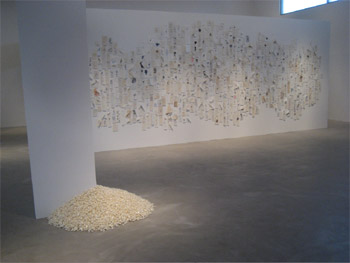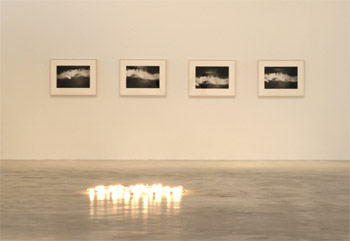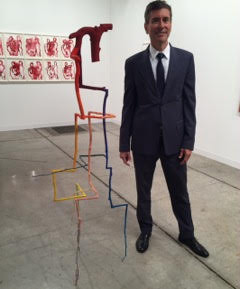Ask AJ
Tony Japour Profiles Felix Gonzalez-Torres


Anthony Japour (AJ) is an independent curator, private art dealer and owner of AJ Japour Gallery. The gallery deals in contemporary art with a focus on the Chinese Contemporary Art Movement and its relationship to the pillars of Western Contemporary Art. Since 2003, AJ has produced numerous art exhibitions and installations in Miami and South Florida. In addition, the Gallery’s secondary mission is to support organizations dedicated to the health, education, and welfare of children. AJ has served on the Fine Arts Board and the Cultural Arts Council of the City of Miami Beach.
Preamble
I’d like to thank SocialMiami for inviting me to contribute a monthly art commentary/critique. Every third week, you’ll see a new article on art- mostly contemporary art- and “Ask AJ” where you can submit questions you always wanted to know but were [maybe] afraid to ask.

With the recent Miami AIDS Walk on April 17th and being that my first career was in medicine researching HIV/AIDS, I decided to write about one of the most important contemporary artists of our time, Felix Gonzalez-Torres, whose work is inextricably linked to the HIV/AIDS pandemic. You can see his work on view at the Rosa & Carlos de la Cruz Collection.
Felix Gonzalez-Torres
3rd Floor
Rosa & Carlos de la Cruz Collection
23 NE 41st Street
Miami, FL 33137
info@delacruzcollection.org
Felix-Gonzalez Torres (1957-1996) was born in Guaimaro, Cuba, grew up in Puerto Rico and shuttled between homes in Manhattan and Miami for a career that spanned less than a decade. Gonzalez-Torres took his training in photography from the Pratt Institute and the International Center of Photography, and experience at the Whitney Museum of Art to create poetic imagery and objects about love and loss in the time of AIDS.
Among Gonzalez-Torres’ best known works, is Untitled (Placebo) 1991, where 1200 pounds of silver-wrapped candy are arranged like a shining metal shag carpet along the floor. The work invites the viewer to take a piece of the candy and be an active participant in the creation (and loss) of the artwork itself. Visually, his work is minimalistic and spare. And while you might think his work might make you sad, it does just the opposite for me with the reflection of light and stillness in the air, I felt buoyant and revived. Indeed, the beauty and poignancy of Gonzalez’ artistic oeuvre is his use of everyday objects, such as candy, typical schoolroom clocks in pairs, light bulbs, blank paper, and paired metal rings to comment on social issues and human relationships.

The relationship between Rosa de la Cruz and Felix Gonzalez-Torres is a dream come true for any art collector and artist. As one of Gonzalez-Torres’ steadfast patrons, Rosa de la Cruz supported his monumental billboard projects in New York City and despite the artist’s passing in 1996, de la Cruz continues to exhibit and promote his work as a valuable legacy of the second half of the twentieth century’s art production.
Jim Hodges, an artist and friend of Gonzalez-Torres was invited by the de la Cruz’ to curate the 3rd floor exhibition space and it is without question the “heart & soul” of the installations on view. One of the most beautifully poetic works is Untitled, 1994, a series of four silver gelatin prints; the series is hung in a specific order and depicts the sea and the heavens. In the first image one sees a single bird floating in the sky; in the second image the appearance of a second bird flying together with the first; in the third, again a bird flying solo, and finally; the two birds reunited—suggesting perhaps the chance meeting of two, sharing a time of love together and, an inevitable separation and loss but ultimately, re-joined together in heaven.
Another work on view is Untitled (Portrait of Dad), 1991 a mound of white mint candies in an endless supply, the “ideal weight: 175 lbs” where Gonzalez-Torres invites the viewer to come closer to his art [and by association, to him] and help themselves to a piece of candy. As Ms. de la Cruz explained to me, Gonzalez-Torres was known for his incredible generosity, always wanting to give to others.
Interested in perhaps owning one of Gonzalez-Torres’ works, I remember once visiting the Andrea Rosen Gallery [the New York City gallery most closely associated with the artist] and naively inquiring about a price of a work on view when I learned that it was not available and that the price of the work I was told was in the millions of dollars!
Dear AJ: Why support “contemporary” art?
I subscribe to Peggy Guggenheim’s philosophy that it’s our duty to protect and promote the art of our own time. Just as Ms. Guggenheim helped to launch Jackson Pollack’s career and Rosa de la Cruz continues to promote the work of Felix Gonzalez-Torres, each of us has the opportunity to support and protect the art of our time. Art history, like other disciplines, builds on and reacts against the work of its predecessors. I particularly like mixing the old and the new—keeps life more interesting!
Please email questions you’ve always wanted to ask, comments, or suggestions for future columns to Anthony Japour at tony@socialmiami.com.

Anthony Japour is an art collector and art advisor. Japour lectures on the Chinese Contemporary Art Movement and its relationship to the pillars of Western Contemporary Art. For over a decade [2002-2012], Japour mounted numerous art exhibitions and installations in Miami Beach and South Florida through AJ Japour Gallery and linked these exhibitions to charity events at his home in South Beach devoted to the health, education and welfare of children. Japour has served on the Fine Arts Board and the Cultural Arts Council of the City of Miami Beach. Japour has been a contributor writing on contemporary art for SocialMiami.com since 2010.


